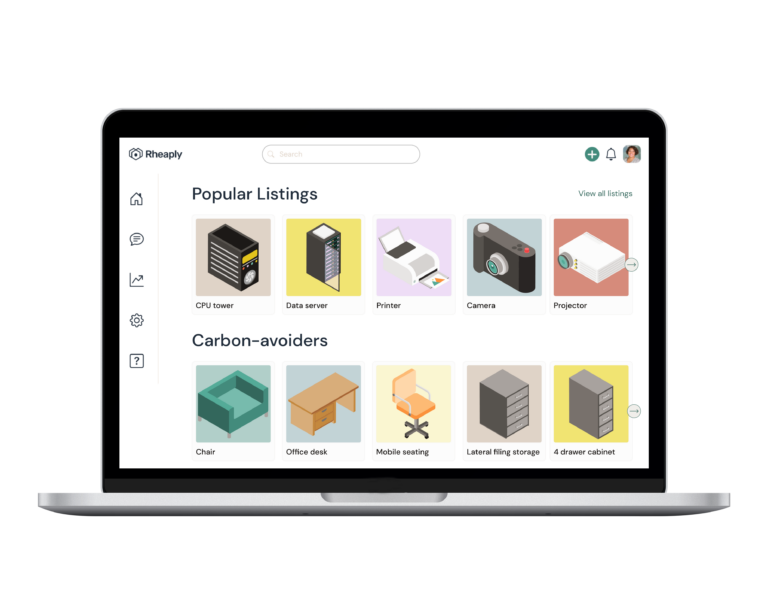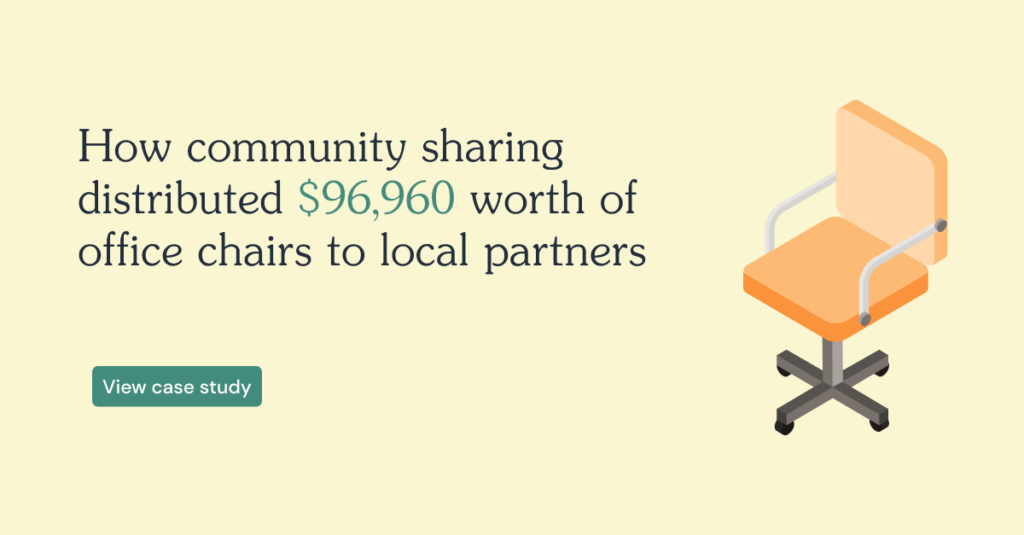Office furniture recycling
Rheaply puts reuse on the table for every organization.
Office furniture recycling
Office furniture recycling is an important practice that facility and procurement managers are increasingly adopting in order to minimize waste and promote sustainability in their organizations. By implementing recycling programs, they can reap several benefits, including cost savings, improved corporate image, and reduced environmental impact.
One of the primary advantages of office furniture recycling is that it allows businesses to cut costs. Those that opt to recycle office equipment can significantly reduce the expenses associated with purchasing new furniture. Office furniture liquidation can also help generate revenue through the sale of used items, which can then be invested in other areas of the organization.
Recycling office furniture benefits the environment as well. It enables organizations to reduce the volume of waste that ends up in landfills, thereby conserving resources, lowering the consumption of raw materials, and reducing greenhouse gas emissions. Consequently, office furniture recycling can contribute to business-critical green initiatives.
In addition, office furniture recycling can boost brand reputation. An increasing number of consumers today are holding businesses accountable for their sustainability practices, which is part of the reason it’s so important for companies to be environmentally-responsible. Businesses that demonstrate a commitment to sustainability are generally seen in a more positive light by customers, employees, and stakeholders alike.
If you’re a facility or procurement manager looking to recycle office chairs—or any other type of office furniture—it can be helpful to partner with a resource exchange platform like Rheaply. These services allow businesses to dispose of their old equipment in sustainable ways, both through recycling and repurposing items.
Rheaply makes it possible for businesses to identify, locate, and utilize their office assets more effectively. Instead of taking your office furniture to the local landfill, consider working with Rheaply to maximize the value of your inventory. By doing so, you can do your part to reduce carbon emissions.
Did you know that 80% of used furniture arrives at landfills every year? That’s 9.6 million tons of furniture with a lot of life left – tossed away. Recycling office furniture can have its challenges – but it doesn’t have to. If you’re wondering how to dispose of office equipment in a way that is cost-effective, efficient, and sustainable – Rheaply has a solution for you.
How to recycle office furniture
Properly recycling office furniture is crucial to reducing waste and promoting sustainability in today’s world. As businesses strive to minimize their operations’ impact on the environment, they are turning to alternative solutions for disposing of old assets. Recycling office furniture is a great way to reduce landfill waste and support a circular economy, which aims to maximize the value of materials by keeping them in circulation for as long as possible.
One of the first steps in promoting sustainability in the workplace is understanding how to recycle office furniture. This process involves multiple steps, including evaluating the condition of the furniture, identifying potential reuse or refurbishment options, and working with recycling services to execute on the recycling strategy.
Partnering with office furniture recyclers is a great way to ensure that office furniture is recycled or repurposed in the most environmentally-friendly manner possible. Professional recyclers have the expertise and resources to dismantle, sort, and process various materials found in office furniture, such as wood and plastic. By collaborating with these organizations, businesses can more easily meet their sustainability goals while reducing the cost of disposing of their assets.
Rheaply is one such example of a company that offers services to help businesses dispose of underutilized and surplus resources and reuse them in a way that’s most efficient. We work with re-manufacturers like Envirotech and The Furniture X-Change to help sustainably sell or donate your surplus office furniture.
When thinking about how to recycle and replace old furniture, consider recycled office furnishings. These are an excellent alternative to purchasing brand-new furniture, as they are both cost-effective and eco-friendly. Recycled furnishings have been refurbished and repurposed to meet required quality standards while also supporting the circular economy.
Ultimately, managers have a range of options when it comes to used office furniture recycling, both in terms of disposing of old assets and purchasing new items. Instead of heading directly to the landfill the minute you decide to get rid of something, it’s important to consider the environmental impact of the process and how you could make things more eco-friendly.
Office furniture removal
Office furniture disposal is essential for maintaining a clutter-free, efficient, and sustainable work environment. It requires a comprehensive approach that involves assessing the furniture’s condition to find appropriate methods to dispose of or repurpose the items. Proper office furniture removal can promote a circular economy, minimize waste, and reduce a company’s environmental footprint.
When considering how to get rid of office furniture, businesses have several options to choose from, including:
- Donating: Many non-profit organizations, schools, and community centers welcome donations of used office furniture. This can be an excellent way to give back to the community while clearing out excess office furniture.
- Selling: Some companies specialize in purchasing and refurbishing used office furniture. Selling excess office furniture to these dealers can be a cost-effective way to manage office furniture removal while ensuring the items are reused rather than taken to a landfill.
- Recycling: If office furniture is beyond repair or deemed unsuitable for reuse, businesses can choose to recycle as an eco-friendly alternative. Partnering with specialized office furniture recyclers can help ensure the appropriate management of materials to minimize the organization’s carbon footprint.
- Upcycling or repurposing: Creative businesses can upcycle or repurpose outdated or unwanted furniture, giving it a new life within the organization or elsewhere.
Office chair disposal, for example, might involve repairing and reupholstering chairs for continued use, donating them to local organizations, or recycling their components responsibly. The key to effective office furniture disposal is considering the environmental impact of the process, your organization’s desired ROI, and then acting accordingly to achieve the best outcomes across the board.
The office furniture removal process can be made much easier by working with an asset exchange platform that specializes in helping businesses manage their old equipment in sustainable ways. Rheaply’s solutions are designed to facilitate a circular economy by reducing waste and pollution, keeping products in use for as long as possible, and regenerating natural systems.
These solutions and services include on-site support, plans for reducing warehouse space, and help circulating resources. Rheaply works closely with businesses to determine their circularity goals and determine how to best promote change.

Office furniture decommissioning
Office furniture decommissioning refers to the process of removing, repurposing, or disposing of office furniture and fixtures that are no longer needed or have reached the end of their useful life. It often occurs during office relocations, closures, or renovations. The decommissioning of assets is a critical component of asset management, as it helps organizations maintain a sustainable and efficient working environment.
Decommissioning office furniture involves several steps. First, businesses need to evaluate the condition of the items in question and determine whether they can be repurposed or recycled. Next, they need to coordinate the removal and disposal process. In some cases, businesses choose to donate, sell, or otherwise repurpose these items, contributing to a circular economy model.
Learning how to decommission FFE (furniture, fixtures, and equipment) is essential to promoting an efficient process. This encompasses not only furniture, but other elements of an office space, such as lighting, partitions, and built-in storage. FFE decommissioning requires careful planning and coordination to make sure that all assets are handled in a responsible and eco-friendly manner.
Decommissioning office space materials may involve working with specialized service providers or recyclers to properly dispose of, recycle, or repurpose unused items. By taking control of the decommissioning process, businesses can reduce waste, improve their operations, and create more functional and modern workspaces. It is for this reason that more and more businesses are prioritizing recycling over traditional disposal solutions.
It’s important for facility and procurement managers to collaborate closely with their teams when deciding how to deal with old office furniture. Decommissioning can be a complex, multifaceted process that impacts the entire organization, and so managers should work to develop a strategy that accounts for all areas affected by office furniture removal.
Surplus assets
urplus assets are items that are no longer required by an organization. Surplus equipment can result from various situations and typically includes items such as desks, chairs, lighting, and partitions. They can be repurposed, sold, or donated to support sustainability initiatives and reduce waste.
Here are some of the most common reasons that businesses end up with surplus furniture:
- Company relocation or closure: When businesses relocate or close their operations, they may no longer need all their existing equipment, creating a surplus.
- Office renovations or upgrades: When companies renovate or upgrade their office spaces, they might replace old or outdated items with new, more efficient ones, which can also result in surplus fixtures and furniture.
- Space turnover: As organizations expand or downsize their operations, they often need to adjust the amount and type of equipment they place in the office.
Managing surplus assets allows businesses to optimize resource utilization and reduce their environmental impact. By finding ways to repurpose or responsibly dispose of surplus items, businesses can contribute to a circular economy and promote sustainable practices.
Organizations can handle surplus office furniture, fixtures, and equipment in several ways, including:
- Donating to non-profit organizations or local schools, which can benefit from used office items.
- Selling to used office furniture dealers, who can refurbish and resell the items.
- Collaborating with recycling facilities or specialized recycling programs to responsibly dispose of items that cannot be repurposed.
Working with a resource exchange platform like Rheaply can be incredibly helpful when trying to determine what to do with surplus items. Because each business is unique, there isn’t a one-size-fits-all solution to furniture removal and recycling, which is why it can be a good idea to work with a professional service when relocating or renovating your office space. This can ensure maximum ROI and minimal environmental impact.


